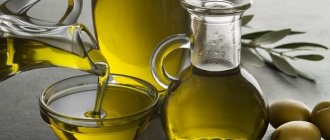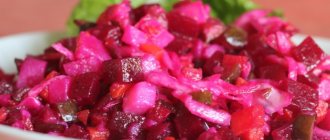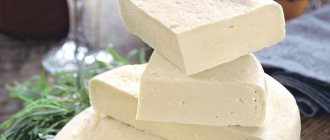Kinds
Flaxseed oil is the leader in the number of therapeutic and prophylactic properties among vegetable oils. The energy value of the product is 844 calories per 100 milliliters. To maintain health, nutritionists recommend taking 15 milliliters on an empty stomach half an hour before meals, or at night 30 minutes after dinner.
To feel the results, it is important to consume flaxseed oil every day, for at least 2 months, without skipping doses. Otherwise you won't notice the changes.
Types of flax seed oil, classified by processing method:
- Unrefined. This is the most useful product, retains its original properties (smell, taste, color), quickly deteriorates and produces fuses during long-term storage. Unrefined oil is “freed” from mechanical impurities through centrifugation, filtration and sedimentation.
- Hydrated. It retains the beneficial properties of unrefined water; in addition, it does not produce sludge (fusa), since it is pre-treated with water to remove phosphatides that give sediment.
- Refined. It undergoes mechanical and chemical cleaning with alkali, which kills valuable free fatty acids. Refined flaxseed oil is shelf-stable, has no sediment, has a weak taste and odor, and is neutral in color. It is of no value to the human body.
- Refined bleached deodorized. In addition to treatment with alkali (refining), the oil is additionally subjected to deodorization and bleaching. The output is a discolored product. Bleaching is carried out with clay, followed by filtering the oil through activated carbon. Like the previous type, it is devoid of useful substances and is inferior in properties to unrefined and hydrated ones.
Flaxseed oil is obtained by crushing peeled flax seeds. Unrefined is produced by pressing, refined - by pressing and extraction. Interestingly, 2 milliliters of the product contains the body’s daily requirement for omega-3 fatty acids. In addition, it is a storehouse of tocopherols (E), vitamin K.
Refined oil has a greenish-yellow color, clean, transparent, without sediment, with a mild taste and smell. Unrefined is divided into 2 grades, in which the permissible content of volatile substances and moisture should not exceed 0.3%. The taste and smell of unrefined flaxseed oil is pure, without bitterness. The permissible sludge by weight for the first grade is up to 0.05%, for the second - 0.1%.
Avoid surrogate drugs and counterfeits, they can worsen your health [1].
Chemical composition
Content of fatty acids in flaxseed oil:
- α-linolenic acid (considered a precursor to omega-3) – 53.4 grams (45 – 70%);
- linoleic (omega-6) – 14.3 grams (12 – 24%);
- oleic (omega-9) – 20.198 grams (10 – 21%);
- palmitoleic (omega-7) – 0.10 grams (0.05 – 0.1%);
- palmitic – 5.10 – 5.30 grams (4.1 – 4.4%);
- stearic – 3.40 – 4.10 grams (3.3 – 3.8%);
- margarine – 0.10 grams (0.05 – 0.1%);
- behenic acid – 0.10 grams (0.05 – 0.1%);
- arachine – 0.10 grams (0.05 – 0.1%);
- lignoceric – 0.10 grams (0.05 – 0.1%).
The mass fraction of saturated fatty acids in 100 grams of product reaches 6 – 18%.
Interestingly, flax seed extract is superior in omega-3 acid content to soybean oil and fish oil.
In addition, it is a valuable source of phytosterols, which are dominated by beta-sitosterol (515% of the daily value is concentrated in 100 milliliters), campesterol (184.5%), stigmasterol (92.9%), delta-5-avenasterol (107 .3%).
Thus, flaxseed oil is classified as a feminine product.
It does not contain oxalic acid, carbohydrates and purine bases. It contains lignans - substances that reduce the level of “bad cholesterol” and normalize the functioning of the cardiac system. These compounds exhibit antimitotic, estrogen-like, and antioxidant activity. Table No. 1 “Nutritional value of flaxseed oil”
| Components | Content per 100 grams of product, milligrams |
| Phytosterols | 689,0 |
| Beta-sitosterol | 206,0 |
| Campesterol | 98,0 –105,0 |
| Unsaturated fatty acids | 87,898 |
| Delta-5-avenasterol | 59,0 |
| Stigmasterol | 30,0 – 35,0 |
| Saturated fatty acids | 9,9 |
| Gramisterol | 6,7 |
| Water | 0,1 |
| Squirrels | 0,1 |
Table No. 2 “Chemical composition of linseed oil”
| Name | Nutrient content per 100 grams of product, milligrams |
| Vitamins | |
| Gamma tocopherol | 28,8 – 52,0 |
| Delta tocopherol | 0,95 – 1,6 |
| Alpha tocopherol | 0,5 – 1,2 |
| Beta tocopherol | 0,6 |
| Choline (B4) | 0,2 |
| Phylloquinone (K) | 0,0093 |
| Macronutrients | |
| Phosphorus | 1,5 |
| Calcium | 1,0 |
Canadian nutritionist Robert Kundi believes that this product is prescribed to make a revolution in the history of mankind for preserving youth in the future [2].
The nutritional value
*The following nutritional information for flaxseed oil (cold pressed) is based on USDA data.
Calorie content of 100 g of flaxseed oil is 884 kcal.
Total nutritional value of 100 g of flaxseed oil:
- Total fat – 99.98 g
- Polyunsaturated fatty acids – 67.84 g
- Monounsaturated fatty acids – 18.43 g
- Saturated fatty acids – 8.97 g
- Proteins – 0.11 g
Acid content in 100 g of flaxseed oil:
- Linolenic acid – 51.9-55.2%
- Oleic acid – 18.5-22.6%
- Linoleic acid – 14.2-17%
- Palmitic acid – about 7%
- Stearic acid – 3.4-4.6%
Vitamin content in 100 g of flaxseed oil:
- Vitamin E – 0.47 mg
- Vitamin K – 9.3 mcg
Mineral content in 100 g of flaxseed oil:
- Calcium – 1 mg
- Phosphorus – 1 mg
- Zinc – 0.07 mg
Beneficial features
Among the beneficial properties of the product are:
- Lowers cholesterol levels, normalizes blood pressure, protects against heart diseases (angina pectoris, hypertension, prevents recurrent heart attacks), reduces blood viscosity. Makes blood vessels more elastic, improves metabolism.
- Relieves inflammation in fibrocystic mastopathy, gout, lupus. Taking flaxseed oil eliminates swelling of the joints and relieves sudden severe pain in them. In addition, omega-3 fatty acids increase the absorption of iodine.
- Relieves constipation, hemorrhoids, diverticular disease. Crushed flax seed is rich in fiber, helps cleanse gastric sacs, prevents the development of possible infections, relieves inflammation, and normalizes the functioning of the digestive tract. The oil has antiparasitic properties, removes colitis, gastritis, and heals the liver. The product prevents the formation of kidney stones and the appearance of cholelithiasis.
- Improves the condition of the skin, is used to treat psoriasis, sunburn, acne, eczema. Essential fatty acids (EFA), which are part of flaxseed oil, eliminate red itchy spots and soothe irritated dermis. In addition, EFAs reduce the secretion of sebaceous glands, the abundance of which clogs pores and causes acne.
- Supports healthy hair and nails. A lack of unsaturated fatty acids causes scalp problems: dandruff, psoriasis, eczema. Omega-3 strengthens fragile nails, prevents their splitting, relieves hair from dryness, dullness, and prevents split ends.
- Improves the transmission of nerve impulses, eliminates tingling and numbness in the limbs, increases the effectiveness of treatment of Parkinson's disease. EFAs prevent nerve damage in multiple sclerosis and diabetes.
- Relieves symptoms of menopause, endometriosis, menstrual pain. Flaxseed oil contains lignins, which normalize hormonal balance. In addition, EFA improves uterine function, helps eliminate infertility problems, and prevents the formation of prostaglandins, which cause bleeding during menstruation.
- Slows down the aging process, reduces the risk of cancer (prostate, colon, breast).
- Resists the occurrence of atherosclerosis, hypertension, stroke, blood clots.
- Fights male infertility, impotence and prostate diseases (prevents inflammation and swelling).
- Stimulates metabolism, improves weight loss, reduces appetite.
- Accelerates the recovery of muscle tissue after intense sports and ligaments after sprains.
- Facilitates the course of pregnancy, has a positive effect on the formation of the brain of the unborn child.
- Increases the effectiveness of treatment of diseases of the nervous system, lungs and bronchi, thyroid gland, kidneys, bladder.
Flaxseed oil is widely used in cosmetology. On its basis, nutritional compositions for hair are prepared that have fortified, bactericidal, rejuvenating, and softening properties.
To prevent stretch marks, it is recommended that flaxseed oil be rubbed into the skin of women, especially during pregnancy, when the dermis is stretched due to the growth of the fetus. When applied regularly (massage movements), it moisturizes, nourishes, and gives a radiant appearance to the body. During feeding, it is applied to the nipples and breasts to protect against the appearance of small cracks and loss of skin elasticity. To speed up the healing of stretch marks and increase the effectiveness of anti-cellulite massage, flaxseed oil is added to the cream [3][4].
What ailments can flaxseed oil help with?
The beneficial properties of flaxseed oil can be listed for a long time. Its healing effect has been known since ancient times. Today, the great benefits of flaxseed oil for the body are proven by research results. It is used both for medicinal purposes and for the prevention of various ailments. Frequent consumption of flaxseed oil helps improve insulin perception in diabetes, reduce the severity of inflammation in joint diseases, and allergic reactions; lowering cholesterol levels in atherosclerosis, maintaining normal blood pressure, reducing the risk of blood clots in blood vessels. Regular intake of flaxseed oil also helps maintain the health of the nervous system, visual acuity and improve intestinal function .
Omega forte, 30 capsules, Evalar
245 ₽
Dietary supplement NOT A MEDICINE
Between us women...
Flaxseed oil is very beneficial for the female body. Its regular use helps with premenstrual syndrome, helping to reduce the severity of pain. Flax seed oil eases menopause and helps prevent diseases caused by age-related hormonal changes (for example, osteoporosis).
Cosmetology is another area of application of flaxseed oil. Under the influence of the beneficial substances it contains, the skin is moisturized and nourished from the inside. In addition, it helps reduce nail brittleness and strengthen hair. Flaxseed oil helps restore dry and damaged hair and also fights split ends.
Flax seeds, 30 sachets of 5 g each, Evalar
249 ₽
Dietary supplement NOT A MEDICINE
Hazardous properties
If consumed uncontrolled, even the healthiest product can be harmful to human health. Flax seed oil quickly oxidizes (when heated and interacts with air) and deteriorates from exposure to sunlight. Because of this, it is not recommended to heat treat it and store it open for a long time. Otherwise, free radicals harmful to the body are formed in the oil.
Thus, the main disadvantage of the product is its short shelf life.
Possible adverse reactions of the body when doses are exceeded:
- Deterioration of blood clotting.
- Diarrhea, but no flatulence is observed.
- Allergic reactions: breathing problems, rash, swelling.
Contraindications to the use of flaxseed oil:
- taking painkillers and antidiabetic drugs;
- pregnancy and hormonal imbalance;
- taking medications whose action is aimed at lowering cholesterol and thinning the blood;
- cholecystitis;
- polyps of the appendages and uterus;
- hepatitis;
- lactation;
- chronic pancreatitis;
- hypertension;
- increased blood clotting;
- fatty liver, disorder of cellular structure;
- taking hormonal contraceptives, antidepressants;
- diseases of the biliary tract;
- atherosclerosis.
Unripe flax pods cause poisoning of the body, and raw seeds contain cyanide (in small doses). The substance has a negative impact on human health. In small doses, it causes a burning sensation in the mouth, agitation, anxiety, increased blood pressure, shortness of breath, dizziness, and profuse sweating. High doses of cyanide are dangerous due to instant loss of consciousness and death [5][6].
How to use?
Flaxseed oil is recommended to be consumed with food without heat treatment. It goes well with fermented milk drinks, juices, cottage cheese, and vegetables. The oil is stored in an opaque glass container, tightly sealed, in the refrigerator. After opening the container, the product is consumed within 5–7 days, otherwise pathogenic microorganisms begin to actively multiply in it.
For an adult, the safe daily dose is 30 milliliters.
Flaxseed oil for weight loss
This is an ideal remedy for correcting body weight, since it contains omega-3,6,9 fatty acids, which take an active part in metabolism, promoting the burning of subcutaneous fat.
For weight loss, flaxseed oil is consumed according to the following scheme: 5 milliliters on an empty stomach 20 minutes before breakfast and in the evening 20 minutes after dinner. In this case, the dose should be gradually increased and increased to 15 milliliters at a time. People with bowel problems should drink 200 milliliters of warm water after taking the oil. If desired, the product can not be consumed in its pure form if it causes concerns and side effects on the body. It can be added to vegetable salads, mixed with honey, fruit syrups, juices, and other oils.
The main condition is not to heat the product, as this destroys its beneficial properties.
If you decide to lose weight with flaxseed oil, you should not expect quick results. The “medicine” will not have any effect in one dose. To achieve a noticeable effect (minus 2 - 5 kilograms), flaxseed oil must be drunk regularly, without skipping doses, for at least 2.5 - 3 months. In addition, without giving up unhealthy foods and systematic physical activity, you won’t be able to lose extra pounds.
The following are excluded from the diet of a person losing weight: fatty, fried foods, red meat (pork, beef), mayonnaise, sauce, wheat flour, baked goods, confectionery, marinades, sugar, processed foods, sweet carbonated drinks, alcohol. Forbidden foods are replaced with vegetables, poultry, fish, fruits, and natural freshly squeezed juices.
Among physical exercises, cycling, running, cardio, fitness, swimming, yoga, and aerobics are welcome.
After a weight loss course, do not refuse to use flaxseed oil. In the absence of contraindications to use, it is added to the daily diet as a source of polyunsaturated fatty acids [7].
Allergy to flaxseed oil
Allergic reactions occur in two cases:
- Individual intolerance;
- Overdose, excess fatty acids in the body.
Manifestations of an allergy to flaxseed oil may be as follows:
- Dizziness, rapid heartbeat;
- Nausea and abdominal pain;
- Skin rashes, swelling;
- Trouble breathing, runny nose.
If negative reactions occur in the body, you should immediately exclude the product from your diet! As an alternative, if you are individually intolerant to flax oil, you can choose another vegetable oil containing fatty acids or fish oil.
Flaxseed oil for face
Every housewife knows that this product is an effective means of getting rid of skin defects: wrinkles, acne, peeling, age spots.
How does flaxseed oil affect the dermis:
- activates collagen production, renews skin cells, promotes tissue restoration;
- tightens the oval of the face;
- moisturizes and improves the smoothness of the dermis;
- relieves inflammation and irritation;
- fights acne;
- protects cells and tissues from the adverse effects of environmental factors;
- improves complexion;
- improves overall skin tone;
- accelerates the treatment of bruises, burns, warts, psoriasis, shingles;
- eliminates dryness, flaking;
- fights shallow wrinkles;
- heals wounds, bruises, cuts and cracks.
When used externally, flaxseed oil nourishes, moisturizes, softens and rejuvenates the skin, so the product is indicated for the care of wrinkled, flabby, dry, aging dermis. When used internally, it stops inflammation in cells, normalizes metabolism, and saturates them with nutrients.
Indications for use:
- pimples, acne;
- first age-related changes on the skin;
- prevention of wrinkles;
- lightening of freckles, dark spots;
- dryness, peeling and feeling of tightness of the dermis.
Directions for use:
- Ingestion. Skin is an indicator of human health. If problems arise with the dermis, you should look for the cause in the body. What do pimples on the face mean? Rashes on the nose indicate the presence of hidden problems with the pancreas, on the bridge of the nose - with the liver, cheeks - with the stomach, temples - with the gallbladder, forehead - with the small intestine or bladder, chin - with the pelvic organs, above the lips - with the heart .
To improve the condition of the skin, the source of inflammation is eliminated and, if necessary, drug treatment is carried out. To enhance the effect, if there are no direct contraindications, flaxseed oil is introduced into the patient’s diet. Daily dose – 30 milliliters, divided into 3 meals. Flaxseed oil is added to salads and warm ready-made porridges. This method of application improves food digestion and prevents the appearance of wrinkles.
- Masks. They have a nourishing, rejuvenating effect on the skin, relieve dryness and flaking. To avoid aggravating the situation, flaxseed oil should be used with caution to care for oily dermis. In order not to increase the work of the sebaceous glands, choose recipes that contain protein or citrus fruits.
- Rubbing the skin. To improve the tone of the face and make the dermis silky, apply flaxseed oil to cleansed skin with massage movements, at least 1 hour before bedtime. Otherwise, the product will not have time to be absorbed, and swelling will appear in the morning.
- Spot use. Used to eliminate microcracks and acne. In this case, the tampon is soaked in linseed oil, which is used to treat problem areas on the skin (warts, bruises, irritations).
- Warm compress. Nourishes and improves the condition of dry, sensitive skin. Directions for use: soak a soft cloth in oil, apply to face, wait 10 minutes.
Face mask recipes:
- For oily skin. Cleanses various impurities, dries out acne, tightens pores. Preparation principle: dilute 15 grams of fresh baker's yeast in the same amount of milk. Stir the mixture to a paste. Let the mask stand for a quarter of an hour, then add 5 milliliters of lemon juice and flax oil. Apply the prepared mixture to your face for 30 minutes, then rinse with warm water.
- For normal skin. Nourishes and softens the dermis. Flaxseed oil is recommended to be used as a replacement for night cream. Apply at night with light patting movements, after removing makeup, do not rinse.
To moisturize and soften the skin, add 3 drops of jasmine essential oil to flaxseed oil, and lemon or orange to relieve fatigue and improve complexion.
- For dry and aging skin. Tightens the dermis, deeply nourishes and moisturizes. Preparation principle: peel ¼ avocado, puree, add 5 milliliters of honey and flaxseed oil to the resulting mass. Mix the contents, apply to the face, wait 30 minutes. After the specified time has passed, rinse off the mask with warm water.
- Cleansing mask. Ingredients: lemon juice (10 milliliters), kefir (15 milliliters), flaxseed oil (5 milliliters), flour (5 grams). Mix the ingredients thoroughly, distribute evenly over the face, leave for 15 minutes, rinse.
A scrub and lotion for acne are prepared using linseed oil. These products cleanse the dermis of impurities and sebaceous secretions, relieve inflammation, and have a tonic and moisturizing effect. To prepare the peeling, flax oil is mixed with oatmeal in equal proportions. The scrub mask is applied with light massage movements onto cleansed skin, gently rubbed in, and rinsed off with warm water. It is recommended to use 1 – 2 times a day.
To prepare an acne cleansing lotion, mix flaxseed oil, yolk, cream, lemon juice, camphor alcohol and honey. Shake the finished lotion vigorously, pour into a glass container, and store sealed. It is recommended to wipe previously cleansed facial skin with the resulting product every day [7].
Application
Valuable and healthy flaxseed oil is successfully used in areas such as the food, pharmaceutical and cosmetic industries. For culinary purposes, it is used as a dressing for vegetable salads, as well as all kinds of side dishes.
Market Analytics
- Global cosmetics market 2021: an unprecedented test for the global cosmetics industry
- Top 10 Cosmetic Research and Development of 2021
- 2020 in the beauty industry – innovation without borders
Convenient search for beauty salons on our website
Beauty salons in Moscow Beauty salons in St. Petersburg Beauty salons in Ekaterinburg Beauty salons in Novosibirsk
Latest blog posts on our website
- Naturecream / Properties of the “Sunny” oil itself
- Naturecream / “Sugar” wrinkles - or what glycation can do
- Naturecream / Esterified oils
- Naturecream / Arnica - the magical plant of alchemists
- Naturecream / Tremella Extract - Snow Mushroom Detox for Skin
- Prostye-sovety / How to visually enlarge your lips with makeup
- Naturecream / Apricot kernel oil for face
- Naturecream / MATRIXYL3000 - the best skin elasticity stimulator
- Naturecream / SPF in Natural Oils
- Naturecream / Geranium (Pelargonium) oil for skin health and beauty
Latest forum topics on our website
- Natalya / How to properly make a gelatin mask?
- Mrs._Smith / Badly sunburned! What to do?((
- Ice / Is it necessary to combine fitness classes with a diet?
- Antonova / What can be used for hair loss?
- Radio operatorKat / Who was on a protein diet?
Other articles in this section
| Mustard oil If you go deeper into history, you can see that wild mustard was first mentioned in the 1st century BC. East Asia is conventionally considered the birthplace of mustard seeds. However, it was no less popular in Ancient Greece due to its piquant taste and medicinal properties, which had a beneficial effect on the body as a whole. |
| Nut oil Nut oil is a collective name for vegetable oils that are produced by cold pressing the grains (kernels) of various types of nuts. As a rule, only mature nut kernels that have been left for some time after harvesting are used to make nut butter. There is no type of nut in nature whose grains are not suitable for preparing this type of product. It should be noted that in terms of their chemical composition, nut oils are superior to most types of vegetable oils and are more expensive. |
| Lemon oil In the world ranking of citrus fruit production, lemons are in third place, behind oranges and tangerines. Fresh unripe lemon fruits produce high quality 100% natural lemon oil. It is a transparent oily substance with a yellow or green tint and a unique lemon aroma. After a certain period of time, the color of the oil may change and turn brown. |
| Rendered beef fat Animal fats are an irreplaceable product in cooking. They are taken from bone tissue, internal organs, and fatty parts. The prepared dishes are not only tasty and aromatic, but also healthy for the human life cycle. |
| Canola oil Consumption of all kinds of oils of natural origin is completely commonplace. Shops and shopping centers offer a wide selection of olive, nut and sunflower oils. But there is a little-known product - canola oil. First of all, it should be noted that this oil is not a product of nature. |
| Safflower oil Safflower oil is a natural product of plant origin, which is obtained from the seeds of the safflower plant by cold pressing, hot pressing or solvent extraction. This type of plant grows in the Crimea, the Caucasus, Egypt, Spain, South America, Africa, and on the Mediterranean coast. In many countries, safflower is cultivated as an oilseed crop and is also used as a natural dye for fabrics and carpets. |
| Rendered mutton fat Rendered mutton fat is a product that has gained respect and fame back in ancient times. It is widely used in various spheres of human activity - in cooking, for medicinal purposes, as a cosmetic product. |
| Poppy oil Poppy oil began to be used in Ancient Greece, since then and to the present day it has been popular. It is obtained by cold pressing poppy seeds. Unrefined oil smells pleasantly of poppy seeds, and after cleansing the smell disappears completely. The color of the oil varies from yellow to golden. |
| Wheat germ oil Wheat is very popular among other grains because it provides the consumer with a wide variety of products with unique nutritional value. One of them is oil extracted from fresh wheat germ using cold pressing. |
| Peasant salted butter Salted peasant butter is made from fermented unpasteurized cream of the highest quality with the addition of a small amount of table salt, and is enriched with microelements. The fat composition must be more than 71.5 percent, and the moisture content must be at least 25%. |
Flaxseed oil for hair
This is a natural healing remedy that improves the condition of lifeless, damaged and dry strands, increases their smoothness and shine, and strengthens the structure. Cold-pressed flaxseed oil is a source of vitamin F (unsaturated fatty acids). The nutrient is responsible for the proper formation, growth and health of hair follicles. In addition, it protects the scalp from dryness, fights split ends, dandruff, nourishes and strengthens the roots, which suffer from temperature changes and lack of vitamins. Therefore, vitamin F is rightfully considered the vitamin of beauty.
Flaxseed oil prevents hair loss, restores its damaged structure, adds shine, softness and elasticity, and restores strength.
Masks to maintain healthy hair:
- For oily hair. Normalizes sebum production, eliminates dandruff, cleans hair and pores of impurities. To prepare the mask, mix the following ingredients: kefir with a fat content of 1% (200 milliliters), linseed oil (30 milliliters). The resulting mixture is rubbed into the scalp, distributed over the entire length of the hair, wrapped in a plastic bag on top, waited for 40 minutes, and washed off with warm water. With regular use (2 – 4 times a week), the hair takes on a fresh, neat appearance and is less likely to become greasy.
- For dry hair. In this case, linseed oil is used without adding additional ingredients. A nourishing mask is applied to the scalp with massage movements, rubbing the product in for 10 minutes, then distributed along the length of the hair. The top of the hair is covered with polyethylene and insulated with a towel. Keep the product on your head for 1 – 2 hours, depending on the degree of hair damage. In severe cases, apply the mask overnight, then wash off with warm water.
- For hair growth. Stimulates metabolic processes in the root zone. To prepare the mask, flaxseed, castor, and sea buckthorn oils are diluted in equal quantities (15 milliliters each). Add rosemary essential oil (5 drops) to the resulting mixture. The mask is applied to the head and hair, covered with cellophane, and wrapped in a scarf. After an hour, the product is washed off with warm water.
To treat brittle, split ends, flaxseed oil is mixed with castor oil and applied to damaged areas of hair. To enhance the effect, hold the strands over steam while applying the product. This helps open pores and better nourish brittle ends.
To “feed”, strengthen the hair structure and give it a natural shine, flaxseed oil (50 milliliters) is mixed with glycerin (30 milliliters), essential compositions (lavender oil for normal, dry hair type, grapefruit or eucalyptus oil for oily hair). The procedure is done at night. The course of therapy is 1 month [7].











